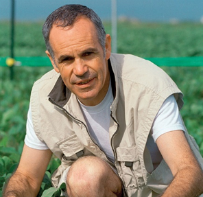Stephen Long

ENG. Stephen Long FRS is Gutgesell Endowed University of Illinois Professor of Crop Sciences and Distinguished Professor of Crop Sciences at the University of Lancaster, UK. His photosynthesis research spans from molecular and in silico design to field analysis of performance. He applies this in increasing genetic crop yield potential and adaptation to global change. He has identified the most productive terrestrial plants so far known from the wild and has studied the attributes that set them apart. He developed SoyFACE; the world’s largest facility for understanding the impacts of atmospheric change on our major food crops under open air field conditions. He is currently Director of Bill & Melinda Gates Foundation international project on Realizing Increased Photosynthetic Efficiency (RIPE). Listed by ISI as one of the Most Highly Cited Authors of 2016. Recent awards: Marsh Award for Climate Change Research from the British Ecological Society, Innovation Award of the International Society for Photosynthesis Research; and Newton-Abrahams Visiting Professorship of Oxford University. He is Founding and Chief Editor of “Global Change Biology”.
ITA. Stephen Long FRS è Gutgesell Endowed Professor di Scienze delle Coltivazioni all'Università dell'Illinois e Distinguished Professor di Scienze delle Coltivazioni all'Università di Lancaster nel Regno Unito. Le sue ricerche sulla fotosintesi spaziano dal design molecolare e in silico all'analisi delle performance sul campo. I risultati dei suoi studi vengono applicati per aumentare il rendimento potenziale delle colture geneticamente modificate e migliorarne l'adattabilità ai cambiamenti globali. Ha identificato le piante terrestri selvatiche più produttive tra quelle finora conosciute, studiandone i tratti che le contraddistinguono. Ha fondato SoyFACE, il più grande centro al mondo per lo studio degli effetti dei cambiamenti atmosferici sulle principali coltivazioni alimentari in condizioni ambientali all'aperto. Attualmente dirige il progetto internazionale Realizing Increased Photosynthetic Efficiency (RIPE) della Bill & Melinda Gates Foundation. Secondo ISI rientra tra gli autori più citati del 2016. Riconoscimenti recenti: Marsh Award for Climate Change Research da parte della British Ecological Society, Innovation Award della International Society for Photosynthesis Research, Newton-Abrahams Visiting Professorship alla Oxford University. È inoltre il fondatore e direttore di “Global Change Biology”.
Engineering crop photosynthesis for sustainable global food security
ENG. Malnutrition costs more lives globally than any other cause. UN-FAO predicts demand for food crops will increase 70% by 2050. Yet the land base for crop production is diminishing and impacted by climate change. At present rates of crop yield improvement, we will fall far short of this need. At the same time, the genetic improvements that fueled the Green Revolution have neared their biological limits. Photosynthesis converts sunlight energy into chemical energy in the form of plant biomass and ultimately our food. Its efficiency in crops falls far short of the theoretical. Crop breeding has failed to increase this efficiency. Computer modeling of the mechanism of photosynthesis and application of optimization algorithms suggest potential for significant improvements. Large productivity increases in field crop trials have resulted from bioengineering of some of these predicted interventions. Insuring against an uncertain future needs full exploration of these opportunities and more successes, soon.
Ottimizzare la fotosintesi delle colture vegetali per raggiungere in modo sostenibile la sicurezza alimentare globale
ITA. La malnutrizione è la principale causa di morte al mondo. Secondo le previsioni della FAO, la richiesta di colture alimentari aumenterà del 70% entro il 2050, ma la superficie destinata alla loro coltivazione è in calo e subisce le ripercussioni negative dei cambiamenti climatici. Se il miglioramento del rendimento delle colture dovesse proseguire al ritmo attuale, presto non saremo più in grado di far fronte alle necessità della popolazione. Al contempo, i miglioramenti genetici che hanno dato il via alla Green Revolution stanno raggiungendo il loro limite biologico. La fotosintesi trasforma la luce solare in energia chimica sotto forma di biomassa vegetale e, infine, di alimenti. Tuttavia, nelle colture la sua efficienza è nettamente inferiore ai limiti teorici e la selezione delle colture non è riuscita a incrementarne l'efficienza. Le simulazioni a computer della fotosintesi e l'applicazione degli algoritmi di ottimizzazione indicano un notevole potenziale di miglioramento. I grandi aumenti di produttività ottenuti nelle coltivazioni trial derivano dall'applicazione di tecnologie di bioingegneria ad alcuni di questi interventi. Per prevenire le incertezze future è necessario esplorare appieno queste opportunità e muovere nuovi passi avanti in tempi brevi.





